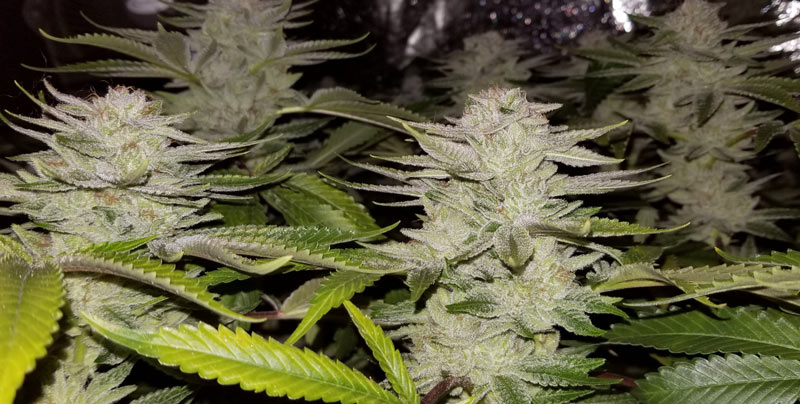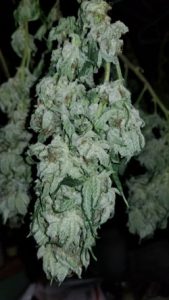Best humidity for weed: best humidity and ideal temp for growing weed
Maintaining the best humidity for weed will allow your marijuana plants to reach their fullest potential.
Controlling humidity and temperature levels in grow rooms can be difficult for beginning marijuana growers who may lack the equipment to control their environment, so selecting a proper location for you grow room is important to ensure you can keep a temperature range and humidity levels for growing weed.
What is the best humidity for growing weed?
Best humidity during vegetation
During the vegetation stage the best humidity for growing weed is around 50%, in a range of 40-60%.
Since marijuana plants absorb water through leaves, keeping weed within this humidity range will ensure that they have the moisture they need without forcing the roots to intake water too quickly, which can cause problems with increased nutrient uptake leading to nutrient burn.

Best humidity during flowering
During flowering, the best humidity for growing weed is slightly lower than during the vegetative stage. Lowering the humidity level for your grow room to 40-50% is best to reduce changes of issues with bud rot.
Late into flower you need to pay especially close attention to maintaining ideal humidity conditions, too damp and you risk bud rot, mold, and mildew problems which will ruin your crop. Many growers look to reduce the humidity levels lower than 40% during late flowering, especially important if you have thick, fat colas that risk issues if kept in too-moist conditions.

Best humidity levels for weed clones
The best humidity level for clones is much higher, since the rootless plants are able to absorb moisture from the air to offset what they can’t draw through their roots. Humidity levels around 75% are great for clones.
Using a humidity plastic humidity dome is helpful to provide the proper humidity levels for clones. Avoid too moist clone conditions or you may run into mold issues. Learn more about how to grow weed clones in coco.
How to lower or raise humidity levels in weed grow rooms
How to lower humidity levels in grow rooms
If you grow marijuana in too humid conditions you risk mold, mildew, and other problems. It’s fairly easy to lower moderately high humidity issues to provide the best humidity for growing weed.
- Proper ventilation will help replace humid grow room air with fresh air, which can lower humidity while bringing in fresh supplies of CO2. Make sure to have lots of air movement blowing on the plants directly, this reduces the chances of problems from humidity issues such as bud rot, mold, or mildew. Learn more about grow room/tent ventilation and proper air circulation.
- Using a dehumidifier can reduce grow room air moisture content quickly. Dehumidifiers can be attached to humidity sensors to keep your room with in a desired range. Learn more about finding a grow tent dehumidifier, or see advice specific to a 4×4 grow tent dehumidifier or a 3×3 grow tent dehumidifier.
- Air conditioners cool air by removing moisture, making them another good way to reduce not only humidity levels but heat levels as well.
- A humidity controller can automate the process by turning on a dehumidifier or air conditioner when a certain humidity threshold is reached. They can also regulate fans to exhaust too-humid air, and can turn on humidifiers when the grow room gets too dry. At around $40 they’re a good option for small or midsize grows.
- Defoliating your marijuana plants can help reduce the amount of large fan leaves the often touch each other and lead to moisture issues. Since these fan leaves release moisture in the air, taking some out will help reduce this. But don’t go nuts and chop away your fan leaves unless you’re sure what you’re doing, removing these leaves will deprive the plant of energy sources.
Learn more about how to lower humidity in a grow tent.

How to raise humidity levels in grow rooms
Having the humidity level of your grow room too low requires that the plant take more water up from it’s roots, which impacts the amount of nutrients it brings in. Marijuana plants in too dry grow room conditions won’t grow as robustly as plants within the proper humidity range for growing weed. Here are a few ways to increase humidity in your grow room:
- Using a humidifier to increase humidity levels in the grow room is the easiest approach. Small drugstore humidifiers require frequent tank fillups, so look for a larger water tank size to avoid constant maintenance. Hooking up your humidifier to a humidity control switch can automate the process of controlling the humidity levels for your weed grow room.
- Using a swamp cooler can also increase moisture levels in grow room conditions that have high temperatures but low humidity. Here’s a tutorial on how to make a swamp cooler from a guy who brought one to Burning Man. It’s helpful to make your own swamp cooler, but those swamp cooler plans use a solar panel for electricity which won’t work so well for indoor grow rooms so you’ll need to make some slight modifications.
What is the ideal temperature for growing weed?
 The ideal temps for growing weed is around 70-80 degrees Fahrenheit, and slightly cooler during the dark period of flowering. The best temp to grow marijuana is room temperature − if it’s comfortable for you then it should be good for your plants. Avoid heat levels above 80 degrees unless you are adding carbon dioxide (CO2) which allows plants to flourish at slightly higher temperatures.
The ideal temps for growing weed is around 70-80 degrees Fahrenheit, and slightly cooler during the dark period of flowering. The best temp to grow marijuana is room temperature − if it’s comfortable for you then it should be good for your plants. Avoid heat levels above 80 degrees unless you are adding carbon dioxide (CO2) which allows plants to flourish at slightly higher temperatures.
Getting an inexpensive thermometer and hygrometer to measure grow room temperature and humidity levels is a good investment. Look for models that capture low and highs for each so you can better understand the range of temps you’re providing your weed plants.
How to lower or raise temperatures in grow rooms
Selecting a proper location for your grow room can help you maintain your ideal temperatures. Cool basements are much easier to control in summertime then spare bedrooms with windows facing the sun. Here are some ways that you can establish the ideal temperatures for your grow room.
How to lower grow room temperatures
If your grow room is too hot, there’s a few things you can do to get your conditions into the ideal temperature range:
- Adjust your approach to lighting. Use air-cooled light hoods or cool-tube hoods connected to an inline exhaust fan. Learn how to make a passive exhaust fan setup connected to air cooled lights. 1000 Watt lights produce a lot of heat, try either reducing to a smaller wattage high pressure sodium or metal halide light fixture, or consider an much cooler option such as LEDs.
- Getting an air conditioner is needed if your grow room environment can’t be addressed properly with just cooling lights. Air conditioners won’t just reduce heat in grow rooms, they’ll also lower humidity levels. Advanced grow rooms running multiple high-wattage lighting fixture often introduce carbon dioxide along with using air conditioners. Adding CO2 will let your plants flourish in much higher temperatures than without.
- Run your light cycle at night during hot summer months.
How to raise temperatures in your grow room
Having too-low grow room temperatures is a nice problem to have. Try getting a larger-size grow light such as a 1000 Watt or 600 Watt, which burn very hot compared to smaller wattage HPS and MH bulbs.
If you’re growing outdoors in an unheated garage or greenhouse there are propane heater and other options to consider. Properly insulating your grow room is another option to control low temperatures in weed grow rooms.
Maintaining the best temperature and humidity levels to grow weed will allow your marijuana plants to grow quickly and develop robust, high-quality buds.
 Drying and curing
Drying and curing
Once your buds are ready to harvest, it’s important to maintain temperature and humidity for weed in your drying area to allow the plants to dry slowly and cure properly.
This increases bag appeal, maximizes terpine profiles, and allows for nice smokeable buds that stay lit in joints and burn to a fine white ash.
Learn more about the best humidity levels for drying and curing in these tutorials:


 Drying and curing
Drying and curing















